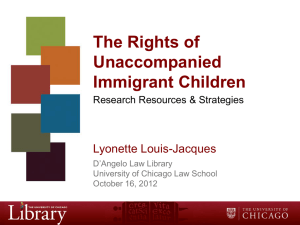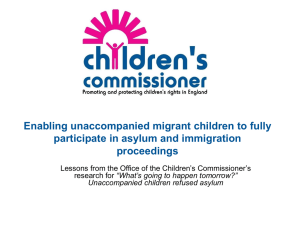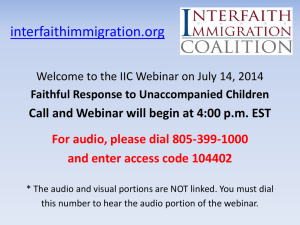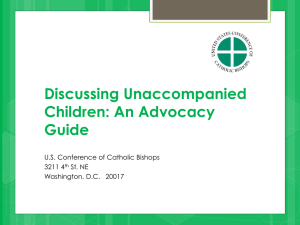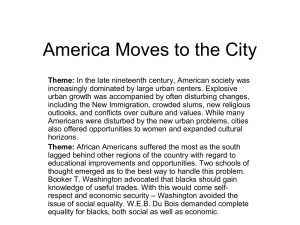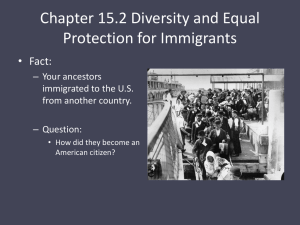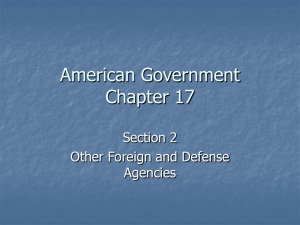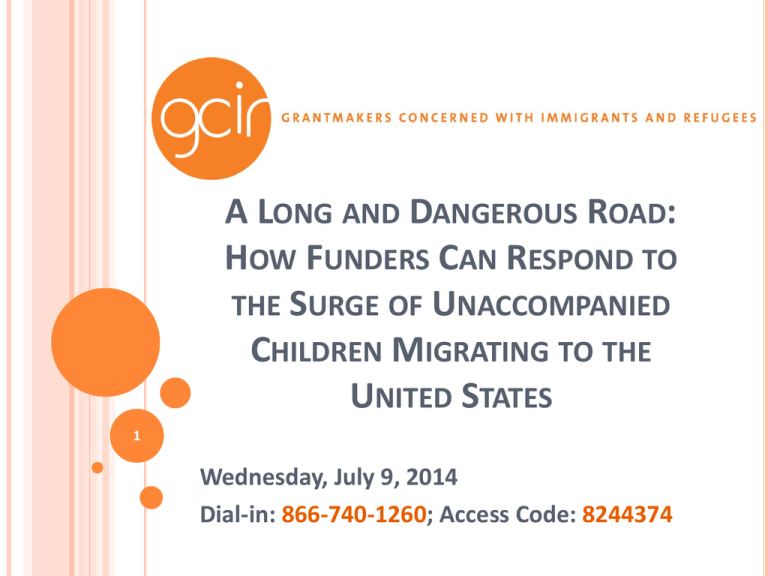
A LONG AND DANGEROUS ROAD:
HOW FUNDERS CAN RESPOND TO
THE SURGE OF UNACCOMPANIED
CHILDREN MIGRATING TO THE
UNITED STATES
1
Wednesday, July 9, 2014
Dial-in: 866-740-1260; Access Code: 8244374
DARANEE PETSOD, GCIR
Daranee Petsod, executive director of Grantmakers
Concerned with Immigrants and Refugees (GCIR),
has worked on social and economic justice issues for
more than 25 years. Prior to joining GCIR in 1998,
she was a program and communications consultant
for foundations and nonprofits. Daranee previously
held leadership positions at the Illinois Coalition for
Immigrant and Refugee Rights and was a program
officer at the Field Foundation of Illinois, Inc. and the
Sophia Fund. She has served on the boards of the
Donors Forum and the Heartland Alliance, both in
Chicago, and the Asian American Justice Center in
Washington, D.C.
2
TARA MAGNER, THE MACARTHUR FOUNDATION
Tara Magner works in the policy research area of
the MacArthur Foundation’s U.S. programs. She
previously served as senior counsel to the chairman
of the U.S. Senate Committee on the Judiciary,
Senator Patrick Leahy of Vermont, from 2009 to
2012. After the 2008 election, Ms. Magner was a
member of President Obama’s Transition Policy
Working Group on Immigration. Previous positions
include commissioner on the American Bar
Association’s Commission on Immigration, director
of policy at the National Immigrant Justice Center in
Chicago, and counsel and professional staff member
to Senator Leahy on the Committee on the Judiciary.
Ms. Magner earned a B.A. at Wesleyan University
and a J.D. at Georgetown University Law Center.
3
THANK YOU TO ALL OF OUR CO-SPONSORS
4
MEETING AGENDA
Welcome, Introductions, and Context Setting
Daranee Petsod, President, GCIR
Tara Magner, Program Officer, MacArthur Foundation
Dr. Robert K. Ross, President and CEO, The California Endowment
Apprehension, Care, Custody, and Release of UACs
Aryah Somers, Consultant
o
Legal and Policy Issues
Maria Woltjen, Director, The Young Center for Immigrant Children’s Rights
Funders’ Perspectives
Betty Balli Torres, Executive Director, Texas Access to Justice Foundation
Tony Banegas, Honorary Consul of Honduras in Phoenix and Philanthropic Advisor,
Arizona Community Foundation
Lina Avidan, Program Executive, Zellerbach Family Foundation
Facilitating a Response by Funders
Tara Magner, Program Officer, MacArthur Foundation
Discussion and Q & A
Closing Remarks and Wrap Up
5
GOALS AND OBJECTIVES
Gain an understanding of the current humanitarian crisis involving
unaccompanied immigrant children.
Hear about the current processes of apprehension, care, custody, and
release as well as key legal and policy issues.
Discuss the role of philanthropy in responding to the needs of this
population.
6
DR. ROBERT K. ROSS, THE CALIFORNIA ENDOWMENT
Dr. Robert K. Ross is president and chief executive
officer for The California Endowment, which during
his tenure has focused on the health needs of
underserved Californians. He previously served as
director of the Health and Human Services Agency
for San Diego County and Philadelphia’s
Commissioner of Public Health. Dr. Ross has served
on numerous boards and commissions, including the
President’s Summit for America’s Future. He has
received numerous honors, including being named
one of the 50 Most Influential Non‐Profit Leaders in
America by the NonProfit Times. Dr. Ross earned an
MPA and M.D. from the University of Pennsylvania.
7
ARYAH SOMERS, CONSULTANT
Aryah Somers is an independent consultant and
researcher on children’s rights and migration policy.
She was a co-author of “Children on the Run,” a
MacArthur Foundation-funded report by UNHCR on
unaccompanied children from Central America and
Mexico to the United States. She has served as a
consultant to CAMMINA on a project mapping
organizations serving migrant children in Central
America and as a Fulbright Scholar in Guatemala.
She has previously worked as a staff attorney at The
Door; a senior program associate at the Vera
Institute of Justice in the Unaccompanied Children
Pro Bono Program; and a consultant on refugee
children for UNHCR/Ecuador. Ms. Somers earned a
J.D. from Georgetown University Law Center and an
M.A. in Arab studies from Georgetown University.
8
Briefing on
Unaccompanied Children
M. Aryah Somers, J.D., M.A.
Consultant
amsomers8@aol.com
© 2014 All Rights Reserved.
WHO ARE UNACCOMPANIED CHILDREN?
• Children
• “Unaccompanied alien children” defined in federal
legislation (Homeland Security Act of 2002):
Children under the age of 18
Without lawful immigration status
Whose parent or legal guardian is not in the US or
is unable or unwilling to provide care and physical
custody
• Refugees and asylumseekers
© 2014 All Rights Reserved.
WHO ARE UNACCOMPANIED CHILDREN?
• Unaccompanied children have been part of our
country historically, and we can and should continue
to be leaders in child protection
• Unaccompanied children are also undetected as:
Children trafficked for sale, prostitution or
pornography
Farmworkers and other forms of child labor
Children who never enter school or fall within any
legal system in the US
Homeless children
DEMOGRAPHIC SNAPSHOT OF UNACCOMPANIED CHILDREN UP UNTIL FY2012
Referred Placements FY 07 - FY 12
FY 07
FY 08
FY 09
FY 10
FY 11
FY12
ECUADOR
100
222
180
268
156
260
EL SALVADOR
1995
1600
1528
2157
1622
3,694
2115
2115
1844
1674
1932
2051
4646
4,646
HONDURAS
2091
1981
1378
1277
1201
3,618
MEXICO
678
711
1067
1490
1392
1,108
NICARAGUA
79
48
29
40
18
53
OTHER
339
252
236
1046
414
246
Total Referred
7397
6658
6092
8210
6854
13625
13625
COUNTRY OF BIRTH
GUATEMALA
© 2014 All Rights Reserved.
Source: DCS, 2012.
Humanitarian crisis for children as they flee across the region in
search of protection.
In 2013 in the US: 24,668 unaccompanied children.
In 2014 in the US: 60,000 unaccompanied children expected.
© 2014 All Rights Reserved.
CHILDREN’S REASONS FOR LEAVING HOME
UNHCR, CHILDREN ON THE RUN REPORT
© 2014 All Rights Reserved
http://www.unhcrwashington.org/children
HISTORICAL CONTEXT OF SYSTEM FOR CARE AND CUSTODY
OF UNACCOMPANIED CHILDREN
• Prior to 2002, the Immigration and Naturalization Service
(INS) in charge of care and custody of children
apprehended at the border and ports of entry
• Homeland Security Act of 2002:
• Created Department of Homeland Security (DHS) and
abolished INS
• Defined “unaccompanied alien children”
• Changed responsibility for the care and custody of
“unaccompanied alien children” to HHS/ORR/Division
of Children’s Services (“DCS”)
© 2014 All Rights Reserved.
HISTORICAL CONTEXT OF SYSTEM FOR CARE AND CUSTODY
OF UNACCOMPANIED CHILDREN
• William Wilberforce Trafficking Victims Protection
Reauthorization Act of 2008 (“TVPRA of 2008”):
• Additional child protection provisions related to placement, care,
custody, home studies and follow-up services for unaccompanied
children
• Identification of best practices for repatriation and reintegration
• Class Action Lawsuits:
• The Flores Stipulated Settlement Agreement, 1997 (Conditions of
Custody)
• Perez-Funez, 1985 (Due process)
• Perez-Olano, 2010 (age-out protections for special immigrant
juvenile status)
© 2014 All Rights Reserved.
U.S. FEDERAL AGENCIES AND
UNACCOMPANIED CHILDREN
JUDICIAL
Department of
Justice:
Executive
Office for
Immigration
Review
(EOIR)
EXECUTIVE
Department of Homeland
Security:
Customs and Border Protection
(CBP)
Immigration and Customs
Enforcement (ICE)
United States Citizenship and
Immigration Services (USCIS)
LEGISLATIVE
Department of
Health and Human
Services:
Office of Refugee
Resettlement
(ORR), Division of
Children’s
Services (DCS)
Department of
State
On June 2, 2014, FEMA was authorized by Presidential Memorandum
to coordinate a response to the humanitarian crisis at the border. The
US Department of Defense authorized the use of military bases to
house unaccompanied children.
FEDERAL SYSTEM: WHAT UNACCOMPANIED CHILDREN ENCOUNTER
CUSTODIAL STRUCTURE UNIQUE TO UAC:
DHS/ICE: Apprehension
and Transfer
DHS/CBP:
Apprehension
DHS/ICE:
Transfer
Placement in federal long-term
care program in the U.S.
ORR/DCS:
Federal
Shelter
Release to Sponsor in the U.S.
Removal to Country of Origin
REMOVAL STRUCTURE FOR ADULTS AND CHILDREN:
Order Removal or Grant Voluntary
Departure to Country of Origin
DHS/ICE and DHS/CBP:
Apprehension,
Interrogation, Preparation
and Filing of Civil Charging
Document
EOIR:
Immigration
Court
Removal
Proceedings
Grant legal relief and no appeal filed
by DHS; if appeal filed, case can
continue to circuit courts
Order removal in absentia
KEY CONCERNS: SCREENING AND RELEASE
OF UNACCOMPANIED CHILDREN
• Providing Know Your Rights information and legal screenings for
preliminary referral to post-release legal services organizations
while children are in-custody
• Providing support to existing capable legal services organizations
in the southern border region to support attorney representation
for children in federal custody
• Support for projects for community-based integration, such as
culturally-informed trauma and mental health services, case
management services, educational models for students with
interrupted education, and child labor rights information
• Access to data on post-release locations to ensure an opportunity
to build response and support systems and support research on
long-term outcomes
© 2014 All Rights Reserved.
MARIA WOLTJEN, THE YOUNG CENTER FOR IMMIGRANT CHILDREN’S RIGHTS
Maria Woltjen is the director and founder of the
Young Center for Immigrant Children’s Rights at the
University of Chicago Law School, where she is also a
law professor and directs a clinic for law and social
work students. The Young Center’s advocates for the
best interests—safety and well-being—of
unaccompanied and separated immigrant children.
She has previously worked at the ChildLaw Center at
Loyola University of Chicago School of Law; the
Children’s Advocacy Project of the Chicago Lawyers’
Committee for Civil Rights; and the law firm of
Coffield Ungaretti Harris & Slavin. Ms. Woltjen
serves on boards and committees in the immigration
field, including the Inter Agency Working Group on
Unaccompanied Children. She earned her J.D. from
the Loyola University of Chicago School of Law.
20
July 2014
Update on Policy
and Legal Issues for
Unaccompanied Immigrant Children:
WHAT IS THE SITUATION TODAY?
Comparison of State Juvenile Systems
and Immigration Courts
CHILD PROTECTION & JJ
IMMIGRATION COURT
State law statutory best interest
standard
No statutory best interests standard in
Immigration and Nationality Act (INA)
Special judges for children’s court
No special judges for children
Statutes and regulations specific to
children’s cases
No INA or regulations specific to
immigrant children
Body of case law specific to children’s
cases
No body of case law governing
children’s cases
Systemic Challenges for Children
in Immigration Proceedings
• No guarantee of legal representation
• Child has the burden of proving eligibility. Must establish
elements of asylum: well founded fear of persecution on
account of race, religion, nationality, political opinion, social
group.
• Child claims don’t fit neatly: gap cases
• Nearly impossible for child to access relief without an
attorney
• There is provision in law re: safe repatriation, but in reality,
safety is not assessed before child is returned.
Practical Challenges for Children
Applying for Status
• Legal services reliant on private funding to
directly represent children
• Pro Bono attorneys not able to take all types of cases
• Legal services providers have to triage cases
• Child must disclose enough information during
screening to constitute claim
• Children appearing pro se (without a lawyer)
Policy Developments
• Children’s Immigration Courts—special dockets for
detained and released children
• Legal Representation Pilot
• Best interests framework
Policy Reforms still Needed
• Legal representation for all children
• Develop child-appropriate Children’s Immigration
Courts
• Independent Child Advocates (best interests
guardians ad litem) for all children
• Implementation of best interests framework
• Ensure safe repatriation of any child returned to
home country
Maria Woltjen
The Young Center for Immigrant Children’s Rights
at the University of Chicago
mwoltjen@uchicago.edu
www.TheYoungCenter.org
FUNDERS’ PERSPECTIVES
Betty Balli Torres, Executive Director with the Texas Access
to Justice Foundation (Austin, TX)
Tony Banegas, Honorary Consul of Honduras in Phoenix
and Philanthropic Advisor with the Arizona Community
Foundation (Phoenix, AZ)
Lina Avidan, Program Executive with the Zellerbach Family
Foundation (San Francisco, CA)
29
FACILITATING A RESPONSE BY FUNDERS
Expand Access to Legal Services
o Scale up immigration legal services
o Recruit, train, support pool of pro bono attorneys
o New federal pilot program “justice AmeriCorps”
Bolster Legal Resources
o Create emergency legal teams
o Expand access to child advocates
o Create a panel of pro bono/low-fee experts to provide medical
information
o Develop country conditions evidence and state specific information
for immigration cases
o Ensure availability of interpreters, including those fluent in
indigenous languages of Mexico and Central America
o Expand training for migration judges and asylum officers
30
FACILITATING A RESPONSE BY FUNDERS
Direct Services
o Fund humanitarian support
o Support human rights monitoring
o Support “wrap-around services”
o Support training for the staff of ORR shelter programs
o Create interagency networks of schools, social services, and legal
services
o Fund mental and physical health services
International
o Support migrant shelters and welcoming centers
o Fund efforts to address the drivers of migration in countries of
origin
o Support programs in countries of origin to: review claims for
asylum; train immigration officials on migrant care; develop child
advocate programs; provide services for youth at-risk for gang
recruitment
31
FACILITATING A RESPONSE BY FUNDERS
Communications
o Support efforts to align communications and advocacy strategies
o Support a media campaign to educate the public
o Fund programs that educate the media
Policy Advocacy
o Support the development of policy recommendations and
advocacy for:
o Systemic restructuring
o Lessons from juvenile court systems with more advanced childsensitive procedures
o Asylum regulations
o Alternatives to detention
o Collection and release of data
o Systems of protection
32
FACILITATING A RESPONSE BY FUNDERS
Check out GCIR’s new briefing on additional ways for funders to
respond available on our website:
33
FUNDER DISCUSSION AND Q & A
34
Learn. Connect. Share.
CLOSING REMARKS AND WRAP UP
35
FOR FURTHER INFORMATION AND/OR TO JOIN A
FOLLOW-UP CALL ON FUNDING OPPORTUNITIES
PLEASE CONTACT:
Harmony Karp Hayes
Director of Programs, GCIR
Email: harmony@gcir.org
36
THANK YOU FOR JOINING TODAY’S
WEBINAR!
37
Please complete our two-minute survey and help inform GCIR’s
future programming and resources!
https://www.surveymonkey.com/s/FJZ2SRX

